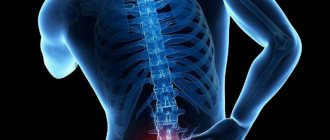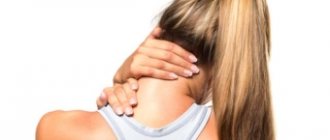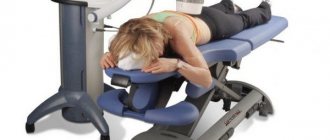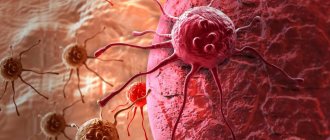Dorsalgia is a collective term for back pain. Discomfort can be localized in any area, but most patients come to see a doctor with pain in the lumbar region. If dorsalgia occurs, consult a doctor, find out the cause of the pathological condition, and begin appropriate treatment.
It is important to understand that dorsalgia is not a disease, but a symptom of any disease of the spine or internal organs; even cancerous formations can cause discomfort in any part of the back. Only an experienced physician, after conducting a series of studies, will find out what caused the back pain. Self-treatment leads to aggravation of the situation, even death.
Causes
There are many diseases that affect the appearance of dorsalgia.
In any situation, this pathology is related: it includes neurological and orthopedic problems. Experts identify several negative factors that affect the appearance of pain in different areas of the back:
- osteochondrosis. The disease is associated with a sedentary lifestyle, intervertebral discs suffer (gradually lose normal blood circulation and their functions). Osteochondrosis accounts for the majority of all patient visits to medical institutions with back pain;
- Bekhterev's disease. A birth defect, men are more susceptible to the disease than women. The pathological process starts in the intervertebral discs, depriving the spine of mobility;
- lumbarization, sacralization, thoracolization. The conditions represent fusion of vertebrae in different parts, which leads to pinched nerve roots, constant tension in the back muscles, and the formation of chronic pain;
- traumatic injuries of the vertebrae. Fractures are not always diagnosed on time; treatment begins with great delay, when the victim exhibits severe dorsalgia;
- spondylolisthesis. The disease is a process in which vertebrae are displaced, a pinched nerve occurs, which leads to constant discomfort in the damaged area (lumbar spondylolisthesis is most common);
- spinal tumors. Even small formations can lead to severe discomfort in the back;
- scoliosis. The pathology can be congenital or acquired; in any case, the curvature of the spine leads to uneven distribution of the load and the formation of dorsalgia;
- bone tuberculosis. The disease is extremely rare, but manifests itself as severe discomfort in the back;
- diseases not related to the spine. This category includes myositis (muscle inflammation), diseases of the gastrointestinal tract, respiratory tract, pain in the thoracic region indicate problems with the cardiovascular system, including myocardial infarction.
Considering the variety of possible causes for the development of dorsalgia, if unpleasant sensations appear, immediately visit a doctor, identify the negative factor, and try to get rid of it.
Learn about the characteristic symptoms and treatment methods for osteochondrosis of the thoracic spine.
Read about what vertebrogenic lumbodynia of the lumbar region is and how to treat the disease at this address.
Types of back pain
According to its origin, dorsalgia is of the following types: compression pain and reflex pain. Compression occurs due to mechanical compression of blood vessels and nerves and has some distinctive features.
So, in this case, there is an irradiation of painful sensations into the arm or leg - the pain radiates to the limb. There may be a decrease in skin sensitivity, a feeling of goosebumps running across the skin, and impaired limb function.
During the examination, the specialist notes a decrease in reflexes from one limb, and it is also possible to identify a decrease in muscle mass, which is asymmetrical in nature - one arm becomes thinner than the other, for example. The last symptom appears with a long-term illness.
It is noteworthy that such pain is associated with movements, turns of the body, and can be provoked by sneezing or sudden bending.
Those dorsalgias that are reflexive in nature arise as a result of the destruction of the cartilaginous membrane of the intervertebral disc. In response to its damage, a number of complex chemical reactions are launched in the body, which are initially aimed at protecting other tissues of the spine, but later cause severe tension in the surrounding muscles and pain.
Read also…. How to cure glenohumeral periarthritis: doctor's advice
This type of dorsalgia can be distinguished by a dull, aching pain that does not respond to body movements. The affected area is tense and you can feel a hard, painful muscle.
Clinical manifestations of the disease
Dorsalgia manifests itself in a wide range of clinical manifestations. The nature of the pain and its localization depend on the damage to a specific part of the spine.
Cervical region
Characteristic manifestations of cervical dorsalgia:
- the initial stages of most ailments are accompanied by periodic nagging pain in the neck; there are no other symptoms. Discomfort increases with sudden turns of the head or staying in one position for a long period of time;
- discomfort is typically spread to the shoulders, back of the neck, in some cases, patients note the appearance of pain in the arms;
- pain disappears after changing body position or completing hard work. Painful attacks usually do not last more than an hour;
- victims complain not only of dorsalgia in the cervical region, but in the absence of therapy they also experience headaches, constant fatigue, sleep disturbances, and memory impairment. These signs are caused by pinched nerve roots, insufficient nutrition of brain cells;
- advanced cases are characterized by hearing loss and visual impairment.
Thoracic dorsalgia
Symptoms of dorsalgia of the thoracic spine:
- Often the appearance of unpleasant sensations in the chest area is preceded by a long-term relaxed state (sleep). After waking up, a person wants to stretch, but his movements are hampered by thoracic dorsalgia. The painful attack goes away within an hour;
- patients note the appearance of intercostal neuralgia (painful shooting in the ribs, the symptom occurs suddenly, a “burning” sensation in the side persists for some time);
- when coughing, sneezing, pain in the thoracic region intensifies;
- after the attacks stop, the heaviness in the shoulder blades remains, and a specific crunch occurs when they are brought together.
Lumbar
Manifestations of lumbar dorsalgia:
- there is pain in the lower back of varying degrees of severity;
- discomfort can spread to the buttock, back of the leg, foot;
- serious pathologies in the lumbar region negatively affect the functioning of the urinary system and contribute to the formation of gynecological and urological problems. Also, lumbar dorsalgia leads to disruptions in the gastrointestinal tract;
- lower back pain forces a person to hunch over, relieving the condition. Subsequently, persistent postural disorders develop, including scoliosis.
On a note! Lumbar dorsalgia is characterized by a decrease in pain when lying on the stomach and increased discomfort after physical activity.
Dorsalgia of the lumbar spine
This type of dorsalgia is designated by the scientific term “lumbodynia.” It is lumbodynia that is the most common reason for visiting a doctor, among all other back diseases; in addition, it usually lasts a long time, becoming chronic.
The lower back is the most load-sensitive part of the spinal column, so pain in this area is most often associated with heavy lifting. However, unpleasant sensations may not appear immediately, but one or two days after the provocation.
Usually the pain is not sharp, but aching, dull in nature, intensifies when bending, turning and decreases in a calm state. Sometimes there may be muscle tension in the lower back on one side; it rarely happens that the muscle is so tense that it is not possible to bend in the opposite direction.
In severe cases, the process involves nerves that control the functions of nearby internal organs. Thus, there may be disturbances in urination, spontaneous bowel movements, and pain in the abdominal area.
Classification
Depending on the location of pain, dorsalgia is divided into several types:
- mixed dorsalgia (unpleasant sensations appear in several parts of the spinal column at once);
- lumbodynia. Discomfort is localized in the lumbar region;
- Thoracalgia. The patient complains of pain in the thoracic region;
- cervicalgia. Unpleasant sensations appear in the cervical region.
Dorsalgia is divided into two types, depending on the cause of back pain:
- vertebrogenic. Discomfort in the back is caused by various ailments associated with the victim’s spinal column;
- nonvertebrogenic. Unpleasant sensations appear against the background of pathologies not related to the spine, for example, diseases of internal organs, psychological factors.
Dorsalgia can be acute or chronic.
Diagnostics
Diagnostic tests will help determine the cause of dorsalgia:
- external examination, palpation of the diseased area, history taking;
- blood and urine tests (allows us to identify inflammatory processes in the body);
- radiography (the pictures show various injuries, degenerative changes in the spine);
- CT, MRI (determining the condition of soft tissues, blood vessels, nerve endings around damaged areas of the spine);
- electromyography (manipulations can reveal the presence of pathologies in the patient’s muscles);
- spinal puncture (intended to detect tumors, purulent, inflammatory processes).
A set of studies will help assess the condition of the patient’s spine, nearby tissues and organs, and find out what caused the discomfort. After making a diagnosis, the doctor will prescribe the necessary course of therapy.
Effective Treatment Options
Most spinal column pathologies are treated with special groups of medications. In each individual case, the doctor selects an individual course.
Universal list of medications:
- NSAIDs (Ibuprofen, Baralgin). Prescribed in the form of tablets, gels and ointments; in case of acute pain syndrome, the drugs are used in the form of injections;
- muscle relaxants (Mydocalm, Baclofen). Helps relax muscles and relieve pain;
- chondroprotectors (Arthra, Chondroitin sulfate). The drugs help restore cartilage tissue and prevent further destruction;
- angioprotectors. By improving conductivity in blood vessels, they normalize metabolism and relieve swelling of damaged areas of the back;
- vitamins. Stimulate metabolism, accelerate blood supply to tissues, and have a beneficial effect on the nervous system;
- glucocorticosteroids (Prednisol, Dexamethasone). Used in cases where NSAIDs do not help. Hormone-containing drugs cope with pain and quickly improve the patient's condition.
Physiotherapeutic treatment
After the acute manifestations of dorsalgia have been relieved, doctors prescribe physiotherapy to the victim aimed at strengthening the muscle corset, restoring motor function, and improving blood circulation in the damaged areas of the spine and nearby tissues.
The following procedures are used to treat dorsalgia:
- magnetic therapy, laser therapy;
- acupuncture, osteopathy;
- swimming, manual therapy, physical therapy, massage;
- mud therapy.
The combination of treatment measures can reduce the risk of relapse, since most spinal diseases are chronic. Surgical intervention is indicated in 10% of cases. Surgeries are resorted to when conservative methods do not help or irreversible damage has occurred in the vertebrae and nearby tissues.
What to do if women have lower back pain and how to treat possible diseases? We have the answer!
The characteristic symptoms and effective methods of treating a pinched lumbar nerve are described on this page.
At this address, see a selection of effective treatment options for spondyloarthrosis of the lumbosacral spine.
Therapeutic measures
Treatment of dorsalgia should be as appropriate as possible to the cause, and all available methods should be used. As a rule, dorsalgia is difficult to treat, but it is possible to prolong the period of remission and reduce the frequency of exacerbations.
Medicines
The main medications used to treat dorsalgia are nonsteroidal anti-inflammatory drugs and analgesics. The most common drugs, the price of which makes them popular among patients, are Ortofen, Ibuprofen, Diclofenac.
They provide a lasting analgesic and anti-inflammatory effect. However, the most unpleasant and common side effect is the development of gastric ulcers. This occurs with prolonged and uncontrolled use of these NSAIDs.
More modern and safer drugs are selective non-steroidal drugs. These include Movalis and Celebrex. The risk of developing stomach ulcers when using them is tens of times less. However, the instructions still do not recommend taking these drugs if you have gastrointestinal diseases.
The most widely used analgesics are Ketonal, Dexalgin, and Nalgesin. They are taken in the form of tablets or intramuscular injections. In case of severe pain, it is advisable to carry out novocaine blockades.
Physiotherapy
Physiotherapeutic methods have a good effect in the treatment of dorsalgia. Under their influence, microcirculation in the spine improves, muscles relax, and the healing of damaged tissues is stimulated.
The most commonly used methods are:
- electrophoresis with aminophylline and novocaine;
- magnetic therapy;
- ultraviolet irradiation.
The procedures are carried out in a clinic setting. The course of treatment may require 5-10 procedures, depending on the disease. It should be remembered that physiotherapy is contraindicated in acute inflammatory processes in the spine.
Massage and gymnastics
Physical exercise is of great importance in the treatment of dorsalgia. Thanks to regular gymnastics, the muscular-ligamentous apparatus is strengthened, the position of the intervertebral discs is restored, and joint flexibility is trained.
Massage helps improve blood circulation in the vertebral area and eliminate muscle spasms. A specialist will tell you more about massage and therapeutic exercises in the treatment of dorsalgia in the video in this article.
Dorsalgia of the thoracic spine, like other parts, requires a comprehensive examination and comprehensive treatment. This can significantly reduce the frequency of relapses and improve a person’s quality of life.
Preventive recommendations
No specific prevention against dorsalgia has been invented, given the huge number of possible causes of the symptom.
Doctors recommend adhering to universal useful recommendations that have a positive effect on the condition of the spine:
- do exercises regularly, the best option is training with a trainer to avoid mistakes;
- balance your diet, drink at least two liters of water per day;
- when working sedentarily, take five-minute breaks, performing simple exercises to relieve muscle tension;
- ensure correct posture;
- If you experience any discomfort, immediately seek help from a doctor.
Dorsalgia is an unpleasant symptom that accompanies most spinal diseases. It is possible to overcome discomfort only in cases where the root cause of the discomfort is eliminated. Take care of your health, if necessary, consult a doctor for help, and refrain from self-medication.
Video - advice from a neurologist about the features of dorsalgia therapy:












